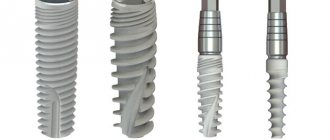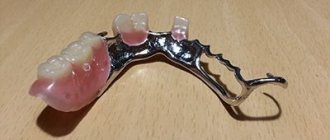A bridge on implants is a reasonable option for prosthetics in case of loss from 3 teeth to their complete absence. Cheaper than implantation of each lost tooth, more reliable than bridge prosthetics on your own teeth.
In our Center they are installed after computer diagnostics and bite examination, and are manufactured in our own dental laboratory. A lifetime warranty is provided for implants in our Center, and 25 years for metal-free crowns as part of a bridge.
A dental bridge on implants is a non-removable orthopedic structure made from welded crowns to restore several teeth in a row.
- Difference from traditional bridges The bridge is supported not by your own teeth, but by pre-installed implants. There is no need to grind down the enamel of adjacent healthy teeth.
- Difference from classical implantation Each tooth does not require a separate implant; fewer are installed. And the bridge includes crowns for each tooth. Allows you to save money.
Bridge prosthesis on implants
Advantages
If you lose several teeth in a row, dental bridges on implants are the right solution. Allows you to correctly distribute the load and not use healthy teeth.
- Neighboring teeth do not deteriorate. The supports are implants implanted into the jaw, and not your own teeth, which must be ground down.
- Durability Implants last a lifetime, and the service life of the prosthesis is at least twice as long as that of classic bridges.
- Aesthetics Crowns are no different from your own teeth. The aesthetic gingival contour is recreated.
- Affordability Savings compared to classic implantation, when each tooth is replaced with an implant and a crown.
What is the difference between a custom abutment and a standard one?
In general, as the name implies, in the first case the abutment is produced individually in a single copy and has a form strictly necessary for a particular case. In the second case, we are dealing with a factory stamped product.
A standard titanium abutment is installed in the oral cavity. Such a standard “cylinder” does not follow the shape of a real tooth and does not maintain the correct shape of the gums. In addition, when fixing the crown to such an abutment, excess cement can easily penetrate deep into the gap between it and the gum.
An individual zirconium abutment is made strictly according to the desired shape, which is usually what a central incisor should have. The gums are well supported. There is no space for cement to “drip” deep under the gum.
The left crown is made on an individual abutment , the right - on a standard one . The difference in shape is obvious. The first has a more regular, natural profile.
Which is better and is there a difference for the patient? Imagine that you come to a shoe store and find a model you like. Everything would be fine, but fashionable boots are produced only in certain sizes, say, 37, 39, 41 and 43. And as luck would have it, yours is 40. Well, at the very least, you can take the 41st and wear your favorite stilettos with a woolen sock. Yes, it’s unaesthetic... but they don’t die from it, do they?! But what if you ate a lot of Rastishka as a child and your feet grew exactly 50?
No extra socks will help here. And this is just a rough comparison. After all, your size may luckily be exactly 39. And so, it looks like the shoes are on, but you still don’t feel comfortable... the foot feels tight in width, but in the instep, on the contrary, everything somehow dangles... In general, it seems to fit, but it’s uncomfortable. Now, in contrast to this, imagine that your shoes will be made to order specifically for your foot, taking into account all its features. In such shoes, even with a 10-centimeter heel, you will feel like you are wearing house slippers. Almost the same can be said about the differences between standard and individual abutments. For work that does not claim to be high-class, especially in terms of aesthetics, in austerity mode, you can get by with standard ones. Well, for example, on chewing teeth. If we are talking about maximum aesthetics and service life, then custom ones are the best choice. It must be said that at the dawn of implantology, the difference in price between factory-made and individually made abutments was significant. Today, with the advent of more and more CAD/CAM* systems, the cost of producing individual abutments from all materials (primarily titanium and zirconium) has actually become equal to the cost of standard factory ones.
Is it always possible to put a bridge on implants?
A bridge prosthesis on implants is suitable in any clinical situation, regardless of the extent and location of the defect in the jaw
Installed when:
- loss of three adjacent teeth in a row; with fewer teeth there is no need
- absence of outer teeth in a row , when there is no support on one side for a conventional bridge
- complete edentia , when there are absolutely no supports for fixation for a traditional bridge
Bridges on implants do not require grinding of adjacent teeth.
They are used even in cases of terminal defects and complete edentia, which cannot be achieved with traditional bridge prosthetics. Another undoubted advantage is that there is no need to prepare the enamel of neighboring teeth, which means they will remain healthy and last longer.
Levin Dmitry Valerievich Chief physician and founder of the Doctor Levin center
What are dental implants
Implant-supported prosthetics differs from classical prosthetic technology. The method is based on the rehabilitation of the dentition without the involvement of healthy units. Instead of a missing or non-viable tooth, a separate implant is implanted - a titanium root that imitates a natural one, onto which an orthopedic structure (crown, bridge, complete denture) is fixed. With the help of dental implants, any number of units can be restored - from 1 to all in a row.
How many implants are needed for partially missing teeth?
When calculating the number of implants, we take into account the distribution of chewing load
The load on the jaw when chewing should be uniform so that there is no subsidence of the gums and bone tissue under the hinged crowns. This will ensure the durability of the prosthesis and maintain aesthetics. Therefore, fixing a bridge on 2 implants is not always the right solution. It is recommended to use a 1:2 calculation - one implant for 2 crowns . Accordingly, the more teeth are missing, the more implants will be needed.
1-2 teeth missing
In this situation, bridges supported by implants are not relevant; teeth are restored separately. Each one has its own implant, which is covered with a separate crown. In this case, it is not recommended to combine crowns - if one is damaged, you will have to remove two at once. No 3 teeth
The most common clinical picture.
If there are no three adjacent teeth in a row, 2 implants are implanted along the edges of the defect, and a prosthesis for 3 teeth in the form of interconnected crowns is fixed on them. The outer ones are mounted on supports, and the middle one is hinged. You can install three implants, but this solution is cheaper. 4 missing teeth
When installing a bridge on 4 missing teeth in a row, the number of supports increases to three, and the number of crowns increases to four.
If you use two supports, then there will also be two mounted crowns. Atrophy of the jaw bone under the prosthesis cannot be ruled out due to uneven load. And the risk of prosthesis breakage increases due to increased pressure on the central part. No 5 teeth
Bridge prosthetics on implants is possible for 5 teeth or more. If five teeth are missing, three implants are needed. If a bridge of 6 teeth or more is required, three supports are used - the number is calculated by the number of crowns in the structure. The degree of future load and its distribution on the bone tissue are taken into account to prevent atrophy.
Main differences from protocols on four and six implants
The main difference is the number of implants (due to this, it was possible to significantly reduce the cost of implantation), as well as the absence of an adaptive prosthesis. In addition, a beam with a unique fastening mechanism is separated into a separate element.
The design of the beam is designed in such a way as to repeat the smooth bend of the lower jaw, protect the mucous membrane from damage, and also compensate for vertical or horizontal deviations of the implant, subject to immediate loading with the prosthesis. In addition, the bar extends beyond the boundaries of the two outermost implants, which makes it possible to attach a prosthesis consisting of a maximum of 12 crowns in a row to it. In protocols for four or six implants, the prosthesis has a similar strong connecting frame, but it is developed strictly individually for the patient, since the doctor is not working with a parallel bone ridge at all.
Expert opinion
Bespalov Roman Dmitrievich Maxillofacial surgeon, implantologist Work experience 26+
“If methods on four and six implants have already been developed over the years of use both around the world and in Russia, then the Trefoil concept may cause some mistrust. But patients do not need to be afraid, they need to cast aside all doubts, because this is a treatment protocol that was developed by Nobel, the founder of all dental implantation. Almost 15 years of work, more than 300 clinical studies. This protocol, if you follow all the recommendations and strictly follow the original concept, simply cannot be bad. Now it has very harmoniously integrated into the complex of immediate loading methods and allows us to give our patients even more opportunities to live a full life.”
Full bridges for the lower and upper jaw
In case of complete edentia, fixed bridge structures are reinforced with a metal arch
The arch unites the crowns, increases the strength of the bridge and allows it to withstand severe chewing loads. The number of implants is determined depending on the clinical picture, anatomical features and jaw size.
- In the upper jaw, bone tissue has a lower density, therefore, during implantation, a larger number of implants are used - 8 pieces.
- On the bottom , on the contrary, the bone is denser, so 6 implants are enough for complete prosthetics. This is subject to standard jaw sizes. If the patient has a large jaw, two more implants are added to evenly distribute the load and ensure safe operation of the prosthesis.
A dental bridge with 6 implants is usually solid, but a denture with 8 implants can be made segmented - from four sections. This is a more convenient option - if necessary, you can remove only one segment, and not the entire prosthesis.
Also, in case of complete absence of teeth, the All-on-4 and All-on-6 protocols are used. 4 or 6 implants are installed on one jaw in a certain way, observing the principles of load distribution. Immediately on the day of implantation, a temporary non-removable adaptive prosthesis is installed, and after 6 months it is replaced with a permanent one.
Indications and restrictions
| Indications | Contraindications to implantation |
| End defects | Mental illness |
| Unsatisfactory condition of the outer teeth | Somatic pathologies in the decompensated stage |
| Segmental row defects | Endocrine disorders, oncopathologies |
| Multiple edentia (absence of more than half of the units) | Acute infectious diseases |
| Complete absence of teeth | Acute inflammatory processes in the oral cavity |
What materials are they made of?
Dentures are manufactured in the Center’s own dental laboratory, you can choose the appropriate option to suit your taste and budget
- Metal-ceramic The base of the crowns is a metal alloy, the top is covered with ceramic mass. Relatively inexpensive, yet durable and quite aesthetic. The main disadvantage of metal ceramics is the ability to oxidize and cause a bluish outline to appear on the gums over time. Service life - 15 years or more .
- Zirconium Can be all-zirconium or coated with ceramics. They can withstand any load, do not deform, and retain their original appearance. Identical to natural teeth, the shade is selected individually. More expensive than metal-ceramic ones, but last longer. Service life - 25 years or more.
We offer patients the most profitable and practical methods, so we reserve the advantage for metal-free structures. In our Center, dental bridges are created in our own digital production using Zirkonzahn Schule technology or at the PROCERA (Nobel Biocare) plant in Sweden.
Stages of installing a bridge on implants
The process includes several stages - diagnostic, surgical and orthopedic
Diagnostics and planning
Computer diagnostics are carried out, the data is necessary to assess the quality of bone tissue, and is used for virtual planning of the operation. In case of extended defects and complete absence of teeth, a bite examination is performed on an articulator so that after prosthetics the correct closure of the jaws is maintained. The treatment plan is drawn up by the orthopedist - he is the one who coordinates the work of the implantologist, determines the positioning points and the number of implants, taking into account future loads.
Implantation
During the operation, a calculated number of implants are implanted into the jaw. When bone tissue atrophies, osteoplasty is performed - bone tissue augmentation. This is necessary to create reliable fixation of the implants. We work only with premium Nobel Biocare systems and use original prosthetics . For anxious patients with cardiac problems, the possibility of surgery in medicated sleep is provided.
Temporary prosthetics
It will not be possible to install a permanent prosthesis immediately after implantation - you cannot create a strong load so as not to disturb the position of the implants. But you will never leave our Center without an orthopedic solution. On the same day, we will manufacture and install a temporary bridge from lightweight materials, which will hide the defect and last 2-4 or 6 months while the implants take root.
Permanent prosthetics
Permanent bridges are made after fittings and prototyping, taking into account the bite. Installed using transocclusal (screw) fixation. Unlike cement fixation, which is practiced in some clinics, the bridge, if necessary, can be removed without damaging the abutments (the connecting link between the implant and the prosthesis).
Operation stages
1. Consultation
The doctor listens to the patient, determines the condition of the teeth, gums and the advisability of implantation, and answers the patient’s questions.
2. Diagnostics
The patient is sent for an x-ray. A 3D computed tomography (CT) scan is performed. Helps to exclude contraindications and assess the volume and condition of bone tissue.
3. Preparation
They organize treatment of dental pathologies (if they are diagnosed), and carry out professional cleaning of the oral cavity.
4. Installation of implants
After anesthesia, the implants are implanted using the method of detaching the gum flap, followed by suturing the gums (with a two-stage protocol) or fixed through a puncture (with a one-stage implantation).
5. Prosthetics
If the operation is organized in 2 stages, 2-6 months after the implantation of titanium roots, the patient is fitted with permanent dentures with crowns made of zirconium dioxide or metal ceramics. While the bone is fused with the implants, the patient wears a temporary removable denture. In a one-stage protocol, the installed artificial roots are loaded with an adaptive prosthesis 2-3 days after surgery. Re-prosthetics with permanent structures are organized after a year.
Bridge on implants or your own teeth - comparison
Each type of prosthetics has its own indications, advantages and disadvantages.
| Tooth-supported bridges | Implant-supported bridges |
| Prosthetic options Up to 3-4 teeth, not suitable for end defects | Prosthetic options From 3 teeth in a row to complete absence |
| Grinding of adjacent teeth is required | Grinding of adjacent teeth Not required |
| Reliability of fastening Possible tooth mobility due to periodontal diseases and inflammation | Reliability of fastening Complete stability due to the fusion of implants with the jaw bone tissue |
| Probability of bone atrophy High - the bone in the area of the defect dissolves and decreases without load | Probability of bone atrophy Low - the load on the bone is uniform due to the installation of the required number of implants |
| Service life Up to 7 years, depending on the condition of the supporting teeth | Service life of a prosthesis - from 15 years, implants - a lifetime |
| Price Lower - costs only for prosthetics | Price Higher - the cost of implantation is added |
In all respects, bridges on implants are superior , the only drawback is the cost in financial and time terms. First, implantation is performed, which requires additional costs and time.
A permanent bridge can be installed only after the implants have healed in order to avoid their displacement during chewing. But this does not mean that you will be left without teeth during this period. Immediately after the operation, we will make a temporary prosthesis that will last until the permanent one is installed and will hide the work performed. You will never leave our Center without teeth!
Dental bridge materials
The bridge structure has excellent quality characteristics, and the material from which the crowns are made is of considerable importance, which largely determines the duration of the operational period of the prosthesis.
Metal-ceramic dental bridge
- The choice of metal-ceramics for creating permanent bridge structures in most clinical cases is the best option in terms of price: quality ratio.
- Thanks to a single solid metal frame, such crowns are very durable, and the outer coating of the crown with a ceramic layer gives it a completely aesthetic appearance.
- The use of metal-ceramics is not limited by the number of teeth, and the duration of the functional period is up to 15 years.
- The technology for manufacturing a metal-ceramic crown makes it possible to accurately reproduce the anatomy of the surface of an artificial tooth and provide it with a functional load.
Plastic dental bridge
- Metal-plastic bridges are widely used due to their economy and lightweight design, which has a metal base lined with a layer of special plastic with a gingival base.
- However, due to the significantly short service life (no more than 3-5 years), such prostheses are often recommended for use during the period of adaptation.
- Metal-plastic structures make it possible to quickly carry out a simple procedure for correcting the bite and are the best option for temporary prosthetics.
Zirconium dioxide dental bridge
- Zirconium dioxide is a light-colored metal from which the frame of the future structure is made, followed by layer-by-layer application of ceramic mass.
- It is not recommended to make bridges with a zirconium dioxide frame in conditions of complete edentia (horseshoe-shaped prosthesis) or partially edentulous with a large extent of defect (half-horseshoe-shaped prosthesis) due to difficulties in fitting the prosthesis.
- But with a small defect of 2-4 teeth, there are no restrictions.
- Zirconium-ceramic bridges are distinguished by high manufacturing precision, have an exceptional natural appearance, and a long-term service life of up to 20 years.
Ceramic dental bridge
- Due to the lack of a frame at the base of crowns made of metal-free ceramics, they cannot be used for bridge structures due to their more fragile structure.
- Pure ceramic crowns are recommended to be installed only in the area of the front teeth, and such crowns have a significant degree of transparency, which gives them a more vibrant appearance.
On the website of the Apex-D clinic you can familiarize yourself with the features and choose the implantation system you like. A bridge structure supported by implants is a worthy solution for restoring the integrity of the dentition.
You can make an appointment at Apex-D Dentistry by calling the administrator at +7 and +7, or filling out an electronic form (the administrator will contact you at the specified phone number and agree on the date and time of the appointment).
Service life of bridges on implants
Implant-supported bridges have increased stability compared to bridges supported on your own teeth. The period of operation does not depend on the condition of the supporting teeth, which over time can become loose from increased loads.
Implants create a uniform load on the bone tissue, eliminating subsidence of the bone under the prosthesis, thereby extending the service life of the structure. Metal-ceramic dentures last from 10 years, zirconium – from 25 years.
a 25-year guarantee on metal-free crowns supported by implants . The Center's warranty on the implants themselves . We use only premium Nobel Biocare implant systems and original prosthetics.
What does the cost consist of?
Our Center provides a case payment system
The implant installation case includes:
- local anesthesia;
- cost of the Nobel Biocare implant and its installation;
- consumables and superstructures;
- applying and removing sutures;
- control CT diagnostics after surgery.
The case for installing a bridge includes:
- taking impressions;
- production of prosthesis;
- fitting and fixation of the structure.
Paid separately:
- Diagnostic case before implantation - the cost depends on the necessary studies.
- Osteoplastic surgery if necessary - the price is calculated depending on the type of bone augmentation and the duration of the defect.
- Sedation - calculated for each hour spent in medicated sleep. Usually 1 hour is enough to install 2-3 implants.
The total cost of bridge prosthetics on implants is formed taking into account:
- length of the defect;
- type and number of implants;
- number of crowns in the structure;
- the need for osteoplasty;
- use of sedation.
Implantation methods
- Classical
operation is carried out in two stages. A two-part artificial root is implanted (the implant and abutment are separate elements) by detaching the gum flap and suturing it into the bone. After 2-6 months, the gums are opened, and abutments are fixed to the implants. The implants are loaded with metal-ceramic or zirconium crowns. Until the titanium roots engraft, the patient wears a temporary removable denture. In case of bone deficiency, implantation is preceded by bone grafting (bone augmentation surgery).
1
Implantation
Implantation of 3 implants
Installation of a butterfly prosthesis or temporary crown (if it is possible to remove the bite)
4-6 months
2
Prosthetics
Installation of abutment and permanent crown
- One-stage
Monoblock implants are implanted (abutments and implants are inseparable) without detachment of the gingival flap - through a puncture in the gum. It is possible to install an implant in the socket of a newly removed unit. On days 2-3 after surgery, an adaptation prosthesis (with a titanium arch and plastic crowns) is fixed. After the artificial roots have engrafted, the temporary structures are replaced with permanent ones (with metal-ceramic or zirconium crowns). In a one-stage operation, implants are implanted into deep layers of bone that are not subject to resorption—bone grafting is not performed.
1
Implantation
Implantation of 3 implants
2 - 3 days
2
Prosthetics
Fixation of an adaptive prosthesis with a titanium arch and metal-plastic crowns
in a year
Permanent prosthetics
The choice of method for implanting three teeth in a row is determined after diagnosis and depends on the location of the defect (front or chewing teeth) and its extent.










